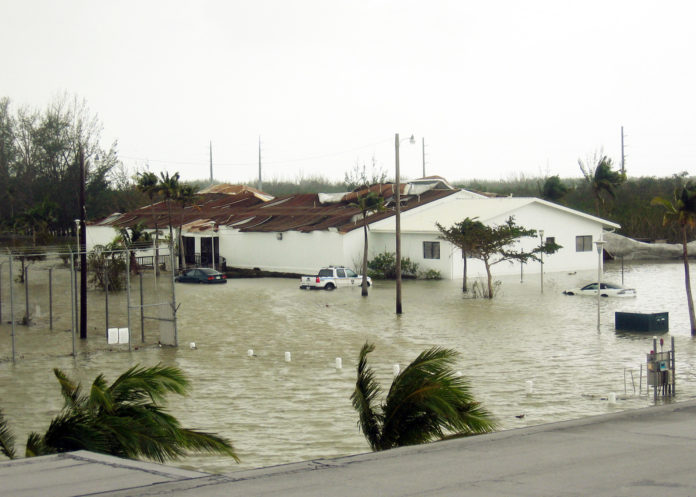
By Jim McCarthy and Alex Rickert
STORM HAD A COMPLICATED BEGINNING
Per a National Hurricane Center report, Wilma formed and became an intense hurricane over the northwestern Caribbean Sea. But it had a complicated beginning.
During the second week of October, a monsoon-like, lower tropospheric circulation and broad area of disturbed water developed over the Caribbean Sea. The system was enhanced by an extensive area of difficult flow to the south and southwest of an upper-level cyclone over the southwestern Atlantic.
The National Hurricane Center’s report states that the easternmost portion of this low pressure area moved northeastward and merged with an extratropical cyclone. However, a more concentrated area of disturbed weather and surface low pressure formed near Jamaica by Oct. 14, 2005, possibly aided by a couple of tropical waves traversing the Caribbean during this time. The next day, surface circulation became well-enough defined, with sufficiently organized, deep convection to designate that a tropical storm formed about 190 miles east-southeast of Grand Cayman.
A weak and ill-defined steering flow prevailed for the first couple of days of Wilma’s existence, with a 500 mb high covering the Gulf of Mexico and another mid-tropospheric anticyclone located well to the east-northeast of the tropical cyclone. The depression moved slowly and erratically westward to west-southwestward for a day or so and then drifted south southwestward to southward for a day or two. There was only slow strengthening during this period, and the system is estimated to have become a tropical storm on Oct. 17. By the next day, Wilma turned toward the west-northwest and, while doing so, strengthened into a hurricane. Later that day, a remarkable, explosive strengthening episode began and continued through early Oct. 19.
“In the span of just 24 hours, Wilma had intensified from a 60-kt tropical storm to a 150-kt category 5 hurricane, an unprecedented event for an Atlantic tropical cyclone,” according to the National Hurricane Center’s report.
THE TRACK
The hurricane continued its move to the northwest in the following days, dropping to a category 4 storm before making its first landfall on Oct. 21 in Cozumel, Mexico. As it moved across the northeast end of the Yucatan peninsula, the storm’s pace slowed, causing extensive damage with extreme rainfall before re-entering the Gulf of Mexico late on Oct. 22 with winds of around 100 mph.
Back in the water, Wilma took a turn to the northeast and intensified as it accelerated toward southern Florida. By the time it made landfall a second time in Cape Romano on Oct. 24, the storm had dropped once again to a category 3 hurricane with winds of 120 mph and a relatively large eye approximately 50-60 nautical miles in diameter.
The storm proceeded to cross the Florida peninsula in roughly 4.5 hours, entering the Atlantic Ocean near Jupiter with winds of 110 mph. It intensified once again as it continued its northeasterly trek, but eventually weakened until it was absorbed by another extratropical storm on Oct. 27.
KEYS HIT WITH SURGES
Storm surges of 4 to 5 feet were observed over much of the lower and middle Florida Keys, locally to near 7 feet. However, a storm surge of near 9 feet was estimated visually in the Marathon area. Storm surges were generally in the 4 to 5 feet range over the upper Keys. This resulted in considerable flooding over substantial portions of the Keys.
Homeowners returning to the Keys had some serious renovation to do — everything from new drywall and tile to purchasing new cars. Insurance claims of more than $208 million were paid out for Hurricane Wilma in Monroe County, according to the state Office of Insurance Regulation.
WHAT WE LEARNED
Wilma smashed several records as it formed and developed. It had the lowest pressure at 882 millibars and the small eye at 2 miles. More important than the records was the fact that it underwent the most extreme intensification in Atlantic history at that time. Given the right conditions, storms have the ability to intensify in just days.
Each hurricane brings a different lesson. With Wilma, it was the wisdom to hide from the wind but run from the water. Emphasis was also placed on the damage caused by storm surges.
BY THE NUMBERS
October 17, 2005: Wilma strengthens into a tropical storm
October 18, 2005: Wilma is declared a hurricane
64.33: Inches of rain dumped on Isla Mujeres in Mexico in a 24-hour span, a Western Hemisphere record that still stands today
185 mph: maximum one-minute sustained wind speeds
5-8 ft.: maximum storm tides above Mean Sea Level recorded from Key West to Islamorada between October 23-24
882 mbar: the lowest pressure recorded during Wilma, the lowest ever observed in the Atlantic basin
$208,810,412: total insurance claim payments made for Wilma in Monroe County
$22.4 billion: estimated total damages from Wilma
Sources: NOAA, National Weather Service, National Hurricane Center























